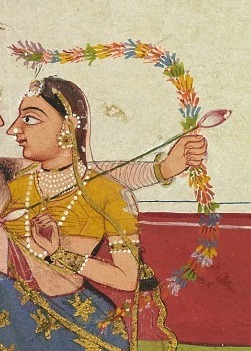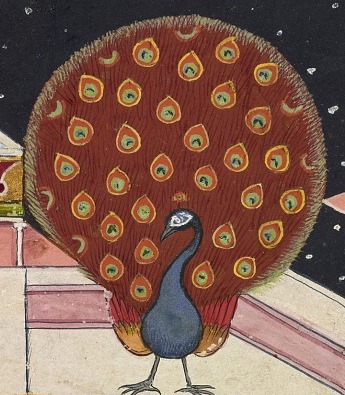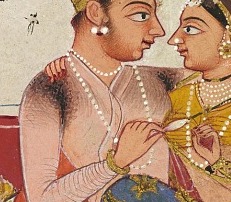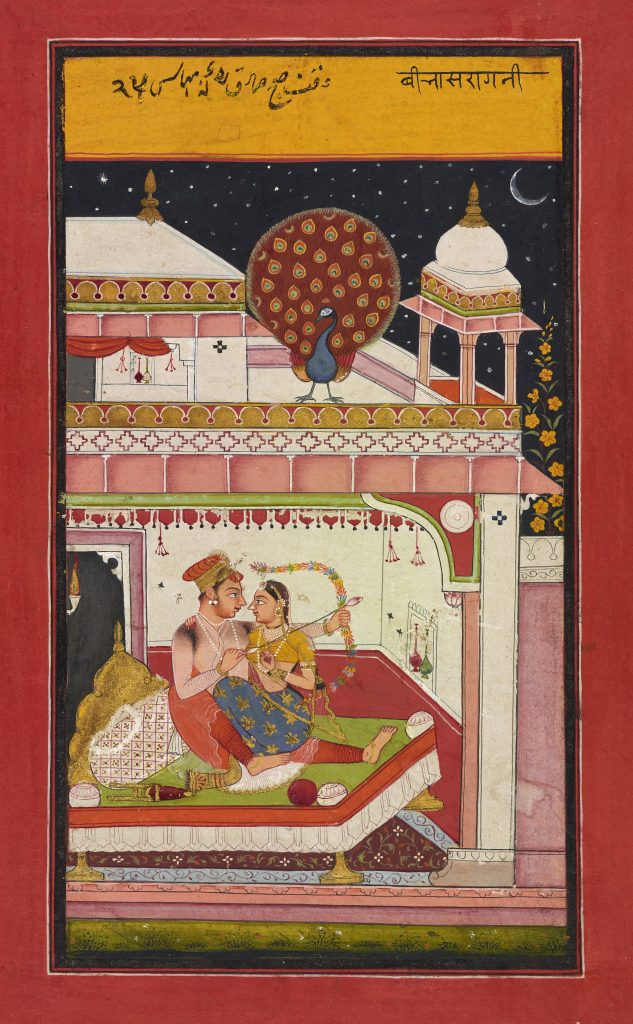Vibhasa Ragini
Vibhasa Ragini
India, Rajasthan, Bundi, ca. 1680
Opaque watercolor and gold on paper
Courtesy the Arthur M. Sackler Gallery, Smithsonian Institution, Washington, D.C.: Purchase and partial gift from the Catherine and Ralph Benkaim Collection — funds provided by the Friends of the Freer and Sackler Galleries, S2018.1.31
The romantic mood of this ragamala painting is expressed by the lovers’ close embrace. The peacock, perched on the roof, disrupts their time together with its loud cries. To silence it, the hero (nayaka) prepares to shoot it down from its perch. By silencing the peacock, the hero hopes to gain a few more precious moments with his heroine (nayika). Their bodies are closely intertwined, emphasizing the romance between them. While the moon indicates that it is not yet dawn, the peacock cries as though it is early morning. The time of day both influences the mood (bhava) of the painting and the musical mode (raga) that would accompany it when viewed.

The bow, made entirely of flowers, is meant to recall Kamadeva, the Indian god of love and desire. Typically, it is Kamadeva’s arrows that are made of flowers, but in this painting the entire bow is formed out of blossoms. The inclusion of this reference to Kamadeva enhances the sensual mood of the painting and reveals the young man’s motivations
The bow and arrow held by the hero are also significant. This is because, upon closer inspection, the viewer can see that the bow he holds is made entirely of flowers. This iconography is associated with the Hindu god Kamadeva. Traditionally, Kamadeva is regarded as the god of sexual feelings, longing, and desire. His arrows are typically associated with the lust of both gods and humans, further emphasizing the sensual nature of this painting. This is something that the connoisseur (rasika), the primary audience for ragamalas, would understand immediately upon viewing the painting. Similarly, the word “kama” (meaning “desire” in Sanskrit) is also understood to be one of the four Hindu goals of life: kama (pleasure), artha (worldly success), dharma (moral correctness), and moksha (spiritual enlightenment). In this case, the reference to kama can be both a reference to this life goal and to the god Kamadeva.

In typical depictions of this raga, two lovers are interrupted by the calls of a rooster in the early morning. In this case, the artist swapped the rooster for a peacock. In ragamala painting, peacocks are associated with romance. This is because they typically mate during the monsoon season, a time with particularly romantic associations. The inclusion of the peacock emphasizes the romantic theme in this painting, as it causes the viewer to recall the monsoon.
A close look at the hero and heroine reveals many indications of their refinement and taste. For example, both are dressed in fabrics that are detailed with intricate patterns and beautiful colors. Similarly, their room is filled with rich textiles and ornamentation. Both the hero and the heroine are wearing fine earrings, necklaces, and bracelets. The hero’s shirt is stained under the arms, indicating that he used a sort of perfumed deodorant, perhaps made from sandalwood or musk. The aromatic scents in the air, the beautiful décor around them, and their own bodies adorned in jewelry heighten the romantic nature of this painting.

Though it may look as if the hero’s shirt is soaked with sweat stains, the dark marks on his shirt are a result of applying a perfume, perhaps musk or sandalwood, under his arms. This aromatic scent increases the romantic tension in the scene.
In most paintings of the same raga, the animal disturbing the couple is a rooster. Here, the artist chose a peacock. The peacock, a common indicator of romance, usually accompanies scenes of intimacy and longing. One reason for this is that peacocks typically cry out and display their feathers during their mating season, which coincides with the arrival of the monsoon rains, a particularly romantic time of year. The decision to swap out the traditional rooster for a peacock was likely a way to emphasize the romantic mood of the painting and an expression of personal ingenuity by the artist.
